Registered with the Registrar of Newspapers for India under R.N.I 53640/91
Vol. XXXI No. 10, September 1-15, 2021
Monsoon magic on our beaches
by A. Rajaram
(Also refer to Vol. XXX No. 21, March 1-15, 2021 for a similar article by the author.)
The gruelling peak of Chennai summer is over. While the temperature dips a little bit by the third week of June, it is still hot and humid. However, by the end of June and early July, our city has received significant rains. The citizens heave a sigh of relief.
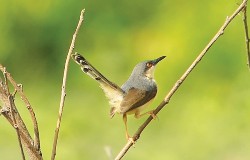 Ashy Prinia |
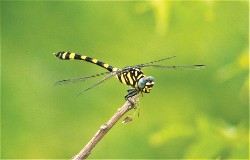 Asian Tiger Dragon fly |
 Plain Prinia |
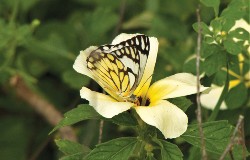 Common Gull Butterfly on White buttercup. |
The minimal rains have resurrected life all around. We decide on a morning walk to the seaside, now that Covid restrictions are relaxed. The tree canopies look green as the rains have washed the white bird droppings clean. The roadside herbs are brought back to life and have bloomed over the past few weeks. The dried-up scrub vegetation on the beach presents a green carpet with shrubs of Calotropis and neem tree bushes dotting the area. Here on the beach, due to the constant breeze, the neem plants keep spreading laterally rather than growing tall. Many such clumps of neem tree bushes, ten to a hundred square feet in area, are present. The Calotropis bushes are more open with flower bunches forming at the top. In the sandy areas between these bushes there are many annual herbs, usually not more than a foot high and all in flower. We notice that they are predominantly cream or yellow. Insect life is prolific with the flowers attracting many species and we see a variety of bees, butterflies, and bugs. We are presented with an abundance of life –All nature wild and free as a popular song of the 1980s goes.
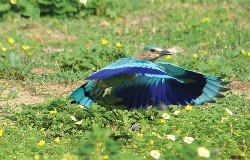 Indian Roller |
 Bee opening petals of beach bean |
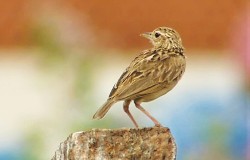 Jerdon’s Bushlark |
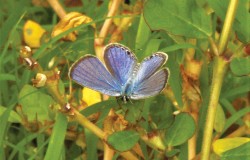 Plains Cupid |
Bird life is remarkable with Redvented bulbuls, Whitebreasted kingfisher, Tailor bird, Common drongos (opportunistically sitting on the body of cattle to feed on the disturbed insects), sunbirds, Small green bee-eaters, Hoopoes and others flying about, sitting on the top of bushes or on the ground itself, looking for food. Today, we are lucky to see a group of Paddyfield pipits feeding on the flies breeding on decaying cattle droppings. We notice with great excitement that the two common prinias of the seaside scrub namely, Ashy Prinia and Plain Prinia, are in their breeding plumage vigorously singing and calling to attract mates or proclaiming a territory. They are chasing rivals or gathering nest materials – grass fibres and woolly fibres from the open pods of the Calotropis plant. The nests are built within the neem bushes cunningly hidden from predators like the Shikra, crows, snakes and even garden lizards. However, it is still a matter of luck if they succeed in rearing a few successful young ones in a season. As we watch the birds, we hear a low whistling, but it takes time for us to locate the Jerdon’s bushlark singing atop a stone pillar. Today, to our delight, an Indian Roller also pays a visit to the beachside and spends a quarter hour feeding on insects and the pods of the Beach bean lying about on the ground. As the day gets warmer, we leave, pleasantly surprised by the resurgence of life brought about by the south-west monsoon, though it brings comparatively less rain to Chennai.
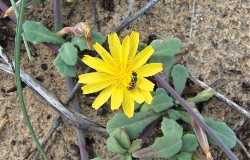 Beach Launaea |
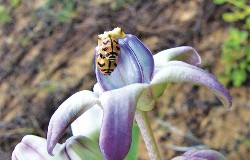 Beetles on Calotropis |
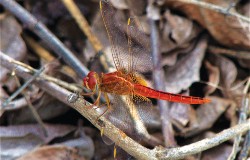 Ruddy Marsh Skimmer |
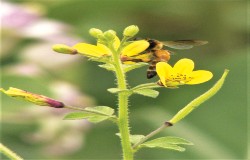 Giant Honeybee on Yellow Spiderflower |
The morning sights have only increased our appetite for an evening sojourn to the same area. Monsoon clouds have been building up over the afternoon. It pours for a good fifteen to twenty minutes and we are caught in the open seaside. However, after the rains pass, we are greeted by a rainbow brightly glowing over the Bay of Bengal, with the sun shining from the west and I feel “My heart leaps up when I behold a rainbow in the sky” – with the added pleasure of the prinias singing in the background!
As I think over the experiences of the day, I feel we should take more interest in creating adequate shrubbery on open areas, such as the neem and Calotropis or other suitable herbs mentioned, and which are native. The beach side I go to is marked out for further construction work. Already it is highly disturbed with people, stray cattle and dogs trampling everything underfoot. People pluck bunches of neem leaves and some also feed crows thereby attracting them to the area. Crows are very opportunistic predators which not only destroy other birds’ eggs but also eat the helpless nestlings. The Corporation is making commendable efforts on planting more trees for increasing greenery. But most of the animal life I described above (like the prinias) depends on shrubs and herbs which are just not present in built-up areas even with plenty of trees planted all over. I hope concerned citizens will spare a thought about the need for adequate shrubbery and not only trees. Such native flora developing into shrubs have been planted in the Adyar Poonga and are well established there.
C2, Century Anchorage
29, 4th Seaward Road
Valmiki Nagar
Tiruvanmiyur, Chennai 600 041.


Lovely pictures — thanks for sharing. Not sure what the Caliptropis is, but regardless…